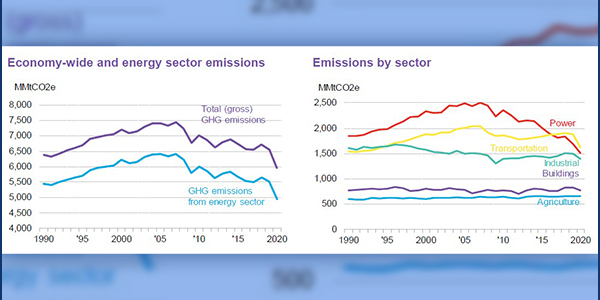The economic slowdown resulting from the coronavirus pandemic caused U.S. greenhouse gas emissions to drop 9% in 2020, putting the country temporarily on track with the Paris Agreement pledge of at least a 26% cut by 2025, according to the 2021 Sustainable Energy Factbook, released Thursday by the Business Council for Sustainable Energy and BloombergNEF.
But no one should be lulled by that seeming progress, Heather Zichal, CEO of the American Clean Power Association, said at a pre-release briefing Wednesday.
The factbook shows transmission investments in the U.S. peaking at $27.1 billion this year but edging down to $26.3 billion in both 2022 and 2023.
“Transmission infrastructure expansion and improvements are critical to enabling the transition to a cleaner electric grid,” Zichal said. “We know we also need new transmission to carry the wind and solar-generated electricity to the towns, cities and manufacturing hubs that are thirsty for clean, affordable power.”
Now in its ninth year, the BCSE Factbook is something of an industry bible, charting the year-by-year U.S. energy transition in detail. For example, the new edition’s top-line figures include 2020’s record-breaking growth in U.S. renewables, with the solar and wind industries adding 16.5 and 17.1 GW, respectively, of new projects to the U.S. grid, despite a midyear slowdown because of the pandemic.
The impact of the pandemic was felt throughout the energy industry in 2020, resulting in a year “of records, but also resilience,” said Ethan Zindler, head of Americas for BNEF.
One of the main, but likely short-lived, effects of the pandemic was the 7.8% drop in energy use across the U.S. in 2020 ― the largest year-on-year decline in at least three decades ― resulting in a 9.2% drop in greenhouse gas emissions. They will likely rebound as the economy recovers, Zindler said, but he noted the U.S. ended the year 20% below 2005 levels, which, at least temporarily, puts the country on target to meet its Paris Agreement pledge of cutting emissions 26 to 28% by 2025.
At the other end of the spectrum, the growth of co-located photovoltaic solar and storage is emerging as a “new asset class of its own,” according to the factbook. With strong storage mandates, and its “duck curve” of mid-day demand drops and steep early evening ramps, California leads the nation with about 21 MWh of co-located storage planned or online.
Climate Commitments Climb
Abigail Ross Hopper, CEO of the Solar Energy Industries Association, said residential solar markets initially were hit hard by the pandemic, “but they were incredibly innovative, incredibly entrepreneurial, figuring out new workflows, new systems, and really did rebound.”
Going into 2021, renewables were buoyed by passage of the $900 billion federal COVID relief package, which included $34 billion in energy spending, split between tax enhancements ― in particular, a two-year extension of the 26% solar investment tax credit ― and research and development.
Other key findings from the 2021 Factbook include:
- The 10 states that have net-zero-emission targets make up about 30% of the U.S. population but account for 35% of the country’s gross domestic product and only 24% of energy-related carbon emissions.
- Corporate demand for clean energy — another key driver for the U.S. renewable energy market — was also hit by the pandemic, with companies signing power purchase agreements totaling 11.9 GW, down from 14.1 GW in 2019. But the number of major corporations making climate commitments continued to grow. The industry group RE100 — composed of companies that have pledged to decarbonize their energy supplies — added 65 new members last year, bringing its total to 285.
- Coal-fired generation, 19% of U.S. energy production, continues to decline, while natural gas provides the largest share of U.S. power at 41%. Gas utilities and companies are positioning themselves as essential components of the energy transition, providing the grid support needed to continue ramping up clean energy. “If you love renewables, you have to at least like natural gas for its long-term and seasonal storage capabilities,” said Lisa Alexander, senior vice president of corporate affairs and chief sustainability officer at Sempra Energy.
While consumer spending on energy overall ticked down 0.5%, spending on electricity edged up, from 1.53% of household expenditures to 1.73%, reflecting the rise in residential energy use and underlining the critical issue of energy equity, said Paula Glover, president of the Alliance to Save Energy.
With students and their parents working at home ― dependent on power for their computers ― electricity and energy efficiency have become “a social justice issue.”
“It’s not just a quality-of-life issue,” Glover said, calling for state and federal action.
“Energy productivity really is about how we use less by doing more,” she said. “We need more efficient homes, energy-efficient appliances, the proper building codes, proper tax incentives. All these things are tools and mechanisms that allow consumers around the country to have an improved, strong quality of life while at the same time managing their bills.”







